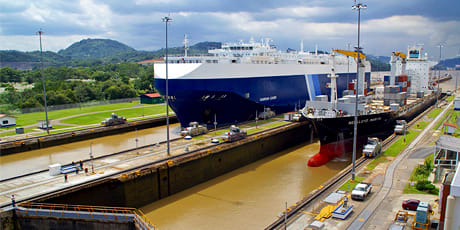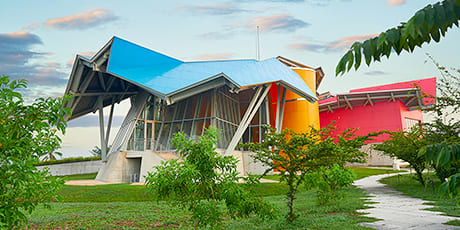 Panama
Panama
Bridging two continents and two oceans, Panama is a country defined by connection of land, culture, and history. Its world-famous canal stands as one of humanity’s greatest engineering feats, yet beyond the locks lies a capital city alive with colonial charm, modern architecture, and tropical rhythm. From the cobblestone streets of Casco Viejo to the lush rainforests that edge the city skyline, Panama blends old and new in seamless balance. Here, travelers can witness how global trade, biodiversity, and local heritage all meet at the crossroads of the Americas.
Tours & Packages
- Destinations: Panama
- including closed packages

Trip Reviews & Photos
We love hearing your stories and seeing your photos! Check out our entire fan photo gallery and upload your photos.
Highlights
- Panama Canal & Miraflores Locks
Opened in 1914 after a decade of intensive engineering, the Panama Canal transformed global trade by providing a shortcut between the Atlantic and Pacific Oceans. At the Miraflores Visitor Center, travelers can watch massive cargo ships and cruise liners traverse the locks, observe the intricate mechanisms that raise and lower vessels, and explore detailed exhibits on the canal’s construction, historical challenges, and ongoing economic significance.
- Casco Viejo (Old Quarter)
Founded in 1673 following the destruction of the original Panama City by pirates, Casco Viejo is a UNESCO World Heritage Site that preserves centuries of history. Its narrow cobblestone streets, ornate colonial churches, and plazas lined with cafes and boutiques reflect the city’s Spanish, French, and indigenous influences. The district offers a living museum of architectural evolution, from Baroque and Neoclassical buildings to modern renovations that maintain historical authenticity.
- Amador Causeway
Extending four miles into the Pacific Ocean, the Amador Causeway links four small islands and provides panoramic views of Panama City’s skyline and the canal entrance. This scenic roadway combines recreation and culture, with bicycle paths, jogging trails, seafood restaurants, museums, and marinas. It also serves as a gateway to wildlife observation, where visitors may spot seabirds and occasional crabs along the shore.
- Biomuseo & Panama’s Biodiversity
Designed by iconic architect Frank Gehry, the Biomuseo examines Panama’s geological role as a land bridge connecting North and South America. Interactive exhibits illustrate how this connection fostered species migration, shaped diverse ecosystems, and contributed to the extraordinary variety of plants and animals found in the region. The museum provides a scientific perspective on Panama’s ecological importance while highlighting conservation efforts.
- Rainforest & Indigenous Culture
A short drive from the city, Soberanía National Park and surrounding tropical rainforests are home to howler monkeys, toucans, sloths, and hundreds of other species. Visitors can also journey along the Chagres River to Emberá villages, where they learn traditional fishing methods, handicrafts, music, and sustainable practices that have been passed down for generations. These experiences provide a deeper understanding of the cultural and environmental heritage that defines Panama.
Fast Facts
Already booked on one of our packages to Panama? See everything you need to know before you go.
| Overview | Capital: Panama City |
| Entry requirements | Please see our Entry Requirements page. |
| Staying Healthy | The risk of mosquito-borne illnesses such as dengue or Zika exists in some regions, so using insect repellent and wearing light, long-sleeved clothing is advised, particularly in lowland and jungle environments. Tap water is safe to drink in Panama City and most major tourist centers, but bottled or filtered water is recommended elsewhere. Panama’s tropical climate can be humid and hot, so staying hydrated and protecting yourself from the sun are important. Quality medical care is available in cities and larger towns, and pharmacies are common. |
| Weather | Panama enjoys a tropical climate year-round, with warm temperatures averaging in the mid-80s Fahrenheit. The dry season runs from mid-December through April, bringing sunny skies and lower humidity—ideal for travel. The rainy season lasts from May through November, with brief but intense afternoon showers common across the country. The Caribbean coast tends to see more rainfall than the Pacific side. Because Panama lies outside the main hurricane belt, it rarely experiences major storms, though humidity can be high throughout the year. Evenings are typically warm, with cooler temperatures in the highlands around Boquete and El Valle de Antón. |
| What to wear | Lightweight, breathable fabrics are ideal for Panama’s warm and humid climate. Casual, comfortable clothing is suitable for most activities, though modest attire is recommended when visiting local villages, churches, or government buildings. A light rain jacket or compact umbrella can come in handy during the rainy season, while a sweater or light layer is useful in cooler highland areas. Comfortable walking shoes are essential for exploring cities, rainforest trails, and the Panama Canal. Beachwear is appropriate at resorts and coastal destinations, but it should be reserved for those settings. Sun protection, including hats, sunglasses, and reef-safe sunscreen, is strongly encouraged. |
| Dining | Panamanian cuisine blends tropical flavors with influences from Latin America, the Caribbean, and the Pacific. Rice and beans are staples, often served with fresh seafood, plantains, and local vegetables. Traditional dishes include sancocho, a hearty chicken stew with yucca and corn, and ropa vieja, shredded beef simmered in tomato sauce. Along the coasts, ceviche made with locally caught fish is a popular favorite. In Panama City, dining options range from casual fondas (local eateries) to sophisticated restaurants offering international fare. Bottled water is widely available, and visitors should ensure seafood and meats are fully cooked when dining in smaller establishments. |
| Money & Credit Cards | Always notify your bank prior to departure to avoid any problems using your credit or debit card while traveling. |
| Shopping | Shopping in Panama offers everything from colorful handicrafts to high-end international brands. The country’s famous indigenous crafts include the intricate molas—vibrant, hand-stitched textile panels made by the Guna women of the San Blas Islands—and tagua nut carvings, woven baskets, and handmade jewelry from various regions. In Panama City, the Casco Antiguo district is filled with artisan boutiques and galleries, while modern malls such as Albrook and Multiplaza feature global retailers. Bargaining is customary in markets but not in stores. Thanks to Panama’s status as a trading hub, imported goods like electronics and luxury items can be excellent values. Visitors will find plenty of opportunities to bring home both cultural keepsakes and modern finds. |
| Cell Phones & Internet | Want to take your cell phone, tablet or laptop, but not sure how to get cell service or wifi? Read up on using your cell phone abroad and the top 5 ways to get Internet abroad. |
| Did you know? |
|

 Opened in 1914 after a decade of intensive engineering, the Panama Canal transformed global trade by providing a shortcut between the Atlantic and Pacific Oceans. At the Miraflores Visitor Center, travelers can watch massive cargo ships and cruise liners traverse the locks, observe the intricate mechanisms that raise and lower vessels, and explore detailed exhibits on the canal’s construction, historical challenges, and ongoing economic significance.
Opened in 1914 after a decade of intensive engineering, the Panama Canal transformed global trade by providing a shortcut between the Atlantic and Pacific Oceans. At the Miraflores Visitor Center, travelers can watch massive cargo ships and cruise liners traverse the locks, observe the intricate mechanisms that raise and lower vessels, and explore detailed exhibits on the canal’s construction, historical challenges, and ongoing economic significance. Founded in 1673 following the destruction of the original Panama City by pirates, Casco Viejo is a UNESCO World Heritage Site that preserves centuries of history. Its narrow cobblestone streets, ornate colonial churches, and plazas lined with cafes and boutiques reflect the city’s Spanish, French, and indigenous influences. The district offers a living museum of architectural evolution, from Baroque and Neoclassical buildings to modern renovations that maintain historical authenticity.
Founded in 1673 following the destruction of the original Panama City by pirates, Casco Viejo is a UNESCO World Heritage Site that preserves centuries of history. Its narrow cobblestone streets, ornate colonial churches, and plazas lined with cafes and boutiques reflect the city’s Spanish, French, and indigenous influences. The district offers a living museum of architectural evolution, from Baroque and Neoclassical buildings to modern renovations that maintain historical authenticity. Extending four miles into the Pacific Ocean, the Amador Causeway links four small islands and provides panoramic views of Panama City’s skyline and the canal entrance. This scenic roadway combines recreation and culture, with bicycle paths, jogging trails, seafood restaurants, museums, and marinas. It also serves as a gateway to wildlife observation, where visitors may spot seabirds and occasional crabs along the shore.
Extending four miles into the Pacific Ocean, the Amador Causeway links four small islands and provides panoramic views of Panama City’s skyline and the canal entrance. This scenic roadway combines recreation and culture, with bicycle paths, jogging trails, seafood restaurants, museums, and marinas. It also serves as a gateway to wildlife observation, where visitors may spot seabirds and occasional crabs along the shore. Designed by iconic architect Frank Gehry, the Biomuseo examines Panama’s geological role as a land bridge connecting North and South America. Interactive exhibits illustrate how this connection fostered species migration, shaped diverse ecosystems, and contributed to the extraordinary variety of plants and animals found in the region. The museum provides a scientific perspective on Panama’s ecological importance while highlighting conservation efforts.
Designed by iconic architect Frank Gehry, the Biomuseo examines Panama’s geological role as a land bridge connecting North and South America. Interactive exhibits illustrate how this connection fostered species migration, shaped diverse ecosystems, and contributed to the extraordinary variety of plants and animals found in the region. The museum provides a scientific perspective on Panama’s ecological importance while highlighting conservation efforts. A short drive from the city, Soberanía National Park and surrounding tropical rainforests are home to howler monkeys, toucans, sloths, and hundreds of other species. Visitors can also journey along the Chagres River to Emberá villages, where they learn traditional fishing methods, handicrafts, music, and sustainable practices that have been passed down for generations. These experiences provide a deeper understanding of the cultural and environmental heritage that defines Panama.
A short drive from the city, Soberanía National Park and surrounding tropical rainforests are home to howler monkeys, toucans, sloths, and hundreds of other species. Visitors can also journey along the Chagres River to Emberá villages, where they learn traditional fishing methods, handicrafts, music, and sustainable practices that have been passed down for generations. These experiences provide a deeper understanding of the cultural and environmental heritage that defines Panama.